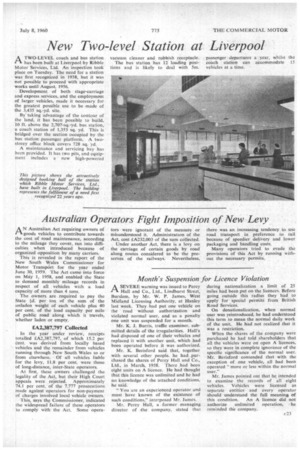Australian Operators Fight Imposition of New Levy
Page 59

If you've noticed an error in this article please click here to report it so we can fix it.
AN Australian Act requiring owners of goods vehicles to contribute towards the cost of road maintenance, according to the mileage they cover, ran into difficulties when introduced because of organized opposition by many carriers.
This is revealed in the report of the New South Wales Commissioner for Motor Transport for the year ended June 30, 1959. The Act came into force on May 1, 1958, and enabled the State to demand monthly mileage records in respect of all vehicles with a load capacity of more than 4 tons.
The owners are required to pay the State Id. per ton of the sum of the unladen weight of each vehicle plus 40 per cent. of the load capacity per mile of public road along which it travels, whether laden or empty,
£A2,387,797 Collected
In the year under review, receipts totalled fA2,387,797, of which 15.2 per Cent. was derived from locally based vehicles and the remainder from vehicles running through New South Wales to or from elsewhere. Of all vehicles liable for the levy, 11.8 per cent, were those of long-distance, inter-State operators, At first, these owners challenged the legality of the Act, but their High Court appeals were rejected. Approximately 74.1 per cent, of the 7,777 prosecutions made against operators for non-payment of charges involved local vehicle owners,
This, Says the Commissioner, indicated the widespread failure of these operators to comply with the Act. Some opera
tors were ignorant of the measure or misunderstood it. Administration of the Act, cost £A232,003 of the sum collected.
Under another Act, there is a levy on the carriage of certain goods by road along routes considered. to be the preserves of the railways. Nevertheless,
there was an increasing tendency to use road transport in preference to rail because of speedier delivery and tower packaging and handling costs.
Many operators tried to evade the provisions of this Act by running without the necessary permits.








































































































